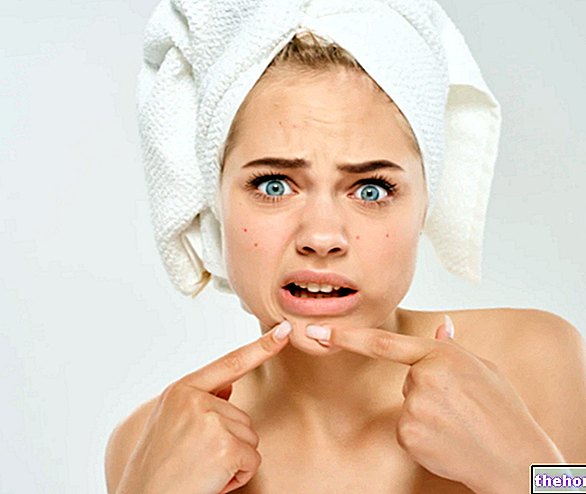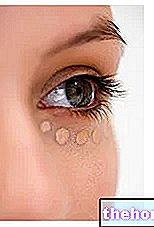Generality
Enlarged pores are very common skin blemishes, affecting women and men, without distinction.

Skin pores are usually not problematic unless they increase in size and become so noticeable that they are unsightly. It may happen, in fact, that these structures become obstructed and widen, constituting a noticeable change in the skin surface.
One of the main causes of dilation is oily skin: often, the pores of the skin tend to widen in case of overproduction of sebum and when they are no longer able to contain an excess of waste substances and dead cells.
The problem of enlarged pores can be difficult to treat, but it can be kept at bay by adopting a healthy diet and regular facial cleansing. There is also a whole series of dermatological and cosmetic treatments that can help make this defect less evident.
What are
Enlarged pores are skin imperfections that affect individuals of a wide age range (10-70 years), of both sexes. This condition can be defined as:
a visible dilation of circular shape and dimensions between 0.1 and 0.6 mm2, which makes the skin tone uneven.
Enlarged pores are not stable but dynamic (ever-changing) skin structures.
The possible causes of enlarged pores are numerous and include many exogenous and endogenous factors, such as genetic predisposition, aging, chronic exposure to ultraviolet light or comedogenic xenobiotics (environmental toxicants, alcohol, drugs, pesticides, chlorinated hydrocarbons, etc. ), acne and seborrhea.
While this blemish is not a cause for medical concern, enlarged pores are a cosmetic defect that is experienced with anxiety by a large number of people.
"Poressia" is the name with which dermatologists have renamed the symptoms related to the presence of enlarged pores on the face.
Causes
Pores are microscopic openings through which the skin releases sebum (matter that is produced by glands in our body). These structures are therefore indispensable for normal skin trophism and it would not be possible to get rid of them permanently. However, some pores appear more dilated and larger than others.
The causal mechanisms of enlarged pores are mainly three:
- Excessive production of sebum (it is no coincidence that the problem mainly affects people who tend to have oily skin);
- Decreased elasticity around the pores (secondary to the loss of elastic fibers, collagen and proteins from the extracellular matrix);
- Increased volume of the hair follicle (therefore, the size of the dermal papilla and the thickness of the hair also affect the dilation of the pores).
The possible exogenous and endogenous factors that contribute to the dilation of pores are:
- Chronic acne;
- Seborrhea;
- Action of sex hormones (including androgens and, in women, progesterone during ovulation);
- Genetic predisposition;
- Damage associated with exposure to ultraviolet light;
- Exposure to comedogenic xenobiotics (environmental toxicants, alcohol, drugs, pesticides, chlorinated hydrocarbons, etc.);
- Lack of daily attention devoted to the care of the skin surface (e.g. use of inappropriate cosmetics and insufficient hygiene).
The dilation of the pores can be influenced by the application of occluding make-up or not suitable for one's skin type. Another wrong habit is that of many women, not to remove make-up before going to sleep; in this way, the pores already open they become clogged.
A further factor that tends to worsen this imperfection is aging, especially in combination with the damage caused by excessive exposure to the sun. Over the years, in fact, the skin loses the usual elasticity and integrity that it possesses at a young age; this can predispose to the enlargement of the pores.
Symptoms, signs and complications
The face is the part of the body most affected by the problem of enlarged pores.
Clinically, the skin appears shiny especially in the mid-facial area of the face (cheek area and T-zone: forehead, nose and chin), "greasy" and thickened with the typical appearance of "oily" skin.
Enlarged pores can be associated with blackheads and pimples.
Diagnosis
Before establishing the appropriate treatment for enlarged pores, it is helpful to identify the underlying causes. First of all, it would be advisable to carry out a skin check-up immediately after puberty, in order to know your skin type in time. This allows you to adapt the cosmetic habits to follow every day to your needs, in order to limit or prevent the appearance of enlarged pores.
If this targeted strategy proves insufficient, the doctor may suggest the use of real drugs. In the latter case, a prescription and constant medical surveillance is necessary.
Treatment
Given the various factors that can cause pores to dilate, the most suitable treatment must be "tailored" to each patient.
Options include medications and therapies that can:
- Reduce the production of sebum;
- Improve skin elasticity.




























